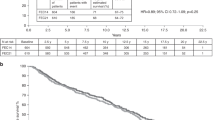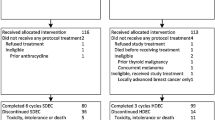Abstract
The intention of chemotherapy for a malignant disease can be either curative or palliative. In breast cancer the former applies to therapy of micrometastatic disease in the adjuvant setting or as a preoperative procedure, while conventionally delivered chemotherapy for metastatic disease is considered to be strictly palliative. The latter statement, however, is challenged by different dose-intensive concepts including the use of high-dose therapy supported by autologous bone marrow stem cells (Bezwoda et al. 1995). The prognosis for breast cancer has been improved by the use of early detection programmes and adjuvant therapy, while the prognosis for patients with metastatic breast cancer is still dismal (Early Breast Cancer Trialists’ Collaborative Group 1992; Nyström et al. 1993; Overgaard et al. 1997; Ragaz et al. 1997).
Access this chapter
Tax calculation will be finalised at checkout
Purchases are for personal use only
Preview
Unable to display preview. Download preview PDF.
Similar content being viewed by others
References
Allerheiligen S, Johnson R, Hatcher B et al (1994) Gemcitabine pharmacokinetics are influenced by gender, body surface area (BSA) and duration of infusion. Proc Am Soc Clin Oncol 13:136
Ardizzoni A, Venturini M, Sertoli M et al (1994) Granulocyte-macrophage colony-stimulating factor (GM-CSF) allows acceleration and dose intensity increase of CEF chemotherapy: a randomised study in patients with advanced breast cancer. Br J Cancer 69:385–391
Bergh J (1997) Dose intensity in patients with metastatic breast cancer — time for novel thoughts? Ann Oncol 8:109–110
Bergh J, Wiklund T, Erikstein B et al (1998) Dosage of adjuvant G-CSF (filgrastim) supported FEC polychemotherapy based on equivalent hematological toxicity to high risk breast cancer patients. Ann Oncol 9:403–411
Bezwoda W, Seymour L, Dansey R (1995) High-dose chemotherapy with hematopoietic rescue as primary treatment for metastatic breast cancer: a randomized trial. J Clin Oncol 13:2483–2489
Bruno R, Hille D, Thomas L et al (1995) Population pharmacokinetics/pharmacodynamics (PK/PD) of docetaxel (Taxotere) in phase II studies. Proc Am Soc Clin Oncol 14:457
Calvert A, Newell D, Gumbrell L et al (1989) Carboplatin dosage: prospective evaluation of a simple formula based on renal function. J Clin Oncol 7:1748–1756
Du Bois D, Du Bois E (1916) A formula to estimate the approximate surface area if height and weight be known. Arch Intern Med 17:863–871
Early Breast Cancer Trialist Collaborative Group (1992) Systemic treatment of early breast cancer by hormonal, cytotoxic, or immune therapy. Lancet 339:1–15, 71-85
EORTC New Drug Development Committee (1985) EORTC guidelines for phase I trials with single agents in adults. Eur J Cancer Clin Oncol 21:1005–1007
Evans W (1993) Alternative approaches for phase I studies of anticancer drugs: a role for therapeutic drug monitoring. Ther Drug Monit 15:492–497
Evans W, Relling M (1989) Clinical pharmacokinetics-pharmacodynamics of anticancer drugs. Clin Pharmacokinet 16:327–336
Grochow L, Baraldi C, Noe D et al (1990) Is dose normalization to weight or body surface area useful in adults? J Natl Cancer Inst 82:323–325
Gurney H (1996) Dose calculation of anticancer drugs: a review of the current practice and introduction of an alternative. J Clin Oncol 14:2590–2611
Hutchison D, Schmid F (1973) Cross-resistance and collateral sensitivity. In: Mihich E (ed) Drug-resistance and selectivity: biochemical and cellular basis. Academic, New York, pp 73–126
Lalisang R, Wils J, Nortier H et al (1997) Comparative study of dose escalation versus interval reduction to obtain dose-intensification of epirubicin and cyclophosphamide with granulocyte colony-stimulating factor in advanced breast cancer. J Clin Oncol 15:1367–1376
Lauterburg B, Preisig R (1991) Quantitation of liver function. In: McIntyre N, Bircher J et al (eds) Oxford textbook of clinical hepatology. Oxford University Press, Oxford, pp 309–314
Mirza M, Jakobsen E, Pfeiffer P et al (1997) Suramin in non-small cell lung cancer and advanced breast cancer — two parallel phase II studies. Acta Oncol 36:171–174
Muhonen T, Jantunen I, Pertovaara H et al (1996) Prophylactic filgrastim (G-CSF) during mutimycin-C, mitoxantrone, and methotrexate (MMM) treatment for metastatic breast cancer. Am J Clin Oncol 19:232–234
Nyström L, Rutqvist L, Wall S et al (1993) Breast cancer screening with mammography: overview of Swedish randomised trials. Lancet 341:973–978
Overgaard M, Hansen P, Overgaard J et al (1997) Postoperative radiotherapy in high-risk premenopausal women with breast cancer who receive adjuvant chemotherapy. N Engl J Med 337:949–955
Paalzow L (1990) Therapeutical drug monitoring of anticancer drugs. In: Domellöf L (ed). Drug delivery in cancer treatment III. Springer, Berlin Heidelberg New York, pp 85–96
Pinkel D (1958) The use of body surface area as a criterion of drug dosage in cancer chemotherapy. Cancer Res 18:853–856
Ragaz J, Jackson S, Le N et al (1997) Adjuvant radiotherapy and chemotherapy in node-positive premenopausal women with breast cancer. N Engl J Med 337:956–962
Ratain M, Mick R, Schilsky R et al (1991) Pharmacologically based dosing of etoposide: a means of safely increasing dose intensity. J Clin Oncol 9:1480–1486
Saarto T, Blomqvist C, Rissanen P et al (1997) Haematological toxicity: a marker of adjuvant chemotherapy efficacy in stage II and III breast cancer. Br J Cancer 75:301–305
Sandström M, Freijs A, Larsson R et al (1996) Lack of relationship between systemic exposure for the component drugs of the fluorouracil, epirubicin, and 4-hydroxycyclophos-phamide regimen in breast cancer patients. J Clin Oncol 14:1581–1588
Schabel FJ, Simpson-Herren L (1978) Some variables in experimental tumor systems which complicate interpretation of data from in vivo kinetic and pharmacologic studies with anticancer drugs. Antibiot Chemother 23:113–127
Smith I, Walsh G, Jones A et al (1995) High complete remission rates with primary neoadjuvant infusional chemotherapy for large early breast cancer. J Clin Oncol 13:424–429
Author information
Authors and Affiliations
Editor information
Editors and Affiliations
Rights and permissions
Copyright information
© 1998 Springer-Verlag Berlin · Heidelberg
About this paper
Cite this paper
Bergh, J. (1998). Tailored Chemotherapy to Equal Toxicity: Is It Possible?. In: Senn, HJ., Gelber, R.D., Goldhirsch, A., Thürlimann, B. (eds) Adjuvant Therapy of Primary Breast Cancer VI. Recent Results in Cancer Research, vol 152. Springer, Berlin, Heidelberg. https://doi.org/10.1007/978-3-642-45769-2_32
Download citation
DOI: https://doi.org/10.1007/978-3-642-45769-2_32
Publisher Name: Springer, Berlin, Heidelberg
Print ISBN: 978-3-642-45771-5
Online ISBN: 978-3-642-45769-2
eBook Packages: Springer Book Archive




